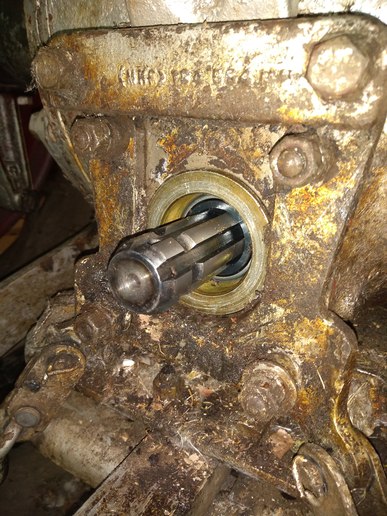Here's what happened: normal level ground, knee high grass, and zero obstructions while cutting- no rocks or stumps of any kind. Running an old Massey MF65 to an FMC Sidewinder 5x5 as I have done for the last 20 years. I heard a series of two or three loud bangs and looked behind me to find the shaft had totally failed with the yoke, separated from both my PTO and the implement shaft, laying on the ground. I limped both back to the garage to investigate and the rotary cutter was freely spinning with the shear bolt on the implement side of the shaft still intact! It is a grade 5 pin and should have broken prior to any shaft failure, I think, so my guess is some other cause than an impulse generated a problem.
Some quick forensics indicated that the overrun coupler on the back of the tractor (attached to the tractor's PTO shaft) had twisted like a tootsie roll before shearing off. That implies the implement shaft failed [u:43e3d5ff8e]first[/u:43e3d5ff8e], the free end spun around once or twice before binding on the tractor, and then sheared the overrun coupler.
Fortunately, after removing the destroyed overrun coupler, it appears the PTO in the tractor itself survived albeit there is a slight wobble on the output (which may or may not have been present prior to the incident). At this time I don't intend on replacing the tractor's PTO shaft as the bearing and seal are holding up well- unless you folks convince me otherwise. It's my intent on replacing the overrun coupler and getting a new implement shaft. If that's all I need to replace, then I feel pretty fortunate.
So my question is why would an implement shaft break in the first place without the shear pin breaking off first? Is fatigue failure ever a legitimate cause for an implement shaft to shatter like this? Do implement shafts have a lifespan and require routine replacement?
Long time lurker/reader (thanks for the help over the years!) and first time poster. Glad to be here.



[/img]
Some quick forensics indicated that the overrun coupler on the back of the tractor (attached to the tractor's PTO shaft) had twisted like a tootsie roll before shearing off. That implies the implement shaft failed [u:43e3d5ff8e]first[/u:43e3d5ff8e], the free end spun around once or twice before binding on the tractor, and then sheared the overrun coupler.
Fortunately, after removing the destroyed overrun coupler, it appears the PTO in the tractor itself survived albeit there is a slight wobble on the output (which may or may not have been present prior to the incident). At this time I don't intend on replacing the tractor's PTO shaft as the bearing and seal are holding up well- unless you folks convince me otherwise. It's my intent on replacing the overrun coupler and getting a new implement shaft. If that's all I need to replace, then I feel pretty fortunate.
So my question is why would an implement shaft break in the first place without the shear pin breaking off first? Is fatigue failure ever a legitimate cause for an implement shaft to shatter like this? Do implement shafts have a lifespan and require routine replacement?
Long time lurker/reader (thanks for the help over the years!) and first time poster. Glad to be here.



[/img]


